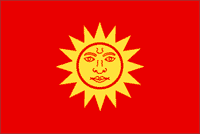
Assam is a state in northeastern India, situated south of the eastern Himalayas along the Brahmaputra and Barak River valleys. Assam covers an area of 78,438 km2 (30,285 sq mi). The state is bordered by Bhutan and Arunachal Pradesh to the north; Nagaland and Manipur to the east; Meghalaya, Tripura, Mizoram and Bangladesh to the south; and West Bengal to the west via the Siliguri Corridor, a 22 kilometres (14 mi) strip of land that connects the state to the rest of India.

Dima Hasao district, earlier called North Cachar Hills district, is an administrative district in the state of Assam in Northeastern India. As of 2011, it is the least populous district of Assam.

Dimapur is the largest city in Nagaland, India. Dimapur District is bounded by Kohima district on the east, Peren District on the south, Karbi Anglong district of Assam on the west and stretch of Golaghat District of Assam, in the west and the north. It is the gateway to Nagaland and its only railhead. The city has the only functional airport in the state. It is the only plains tract of hilly Nagaland and has a railway station and airport space for connectivity and economic activity in the new state. Dimapur is the commercial hub of Nagaland.

Kamarupa, an early state during the Classical period on the Indian subcontinent was the first historical kingdom of Assam.

The history of Assam is the history of a confluence of people from the east, west, south and the north; the confluence of the Tibeto-Burman (Sino-Tibetan), Indo-Aryan and Austroasiatic cultures. Although invaded over the centuries, it was never a vassal or a colony to an external power until the third Burmese invasion in 1821, and, subsequently, the British ingress into Assam in 1824 during the First Anglo-Burmese War.

The Koch dynasty (Pron:kɒʧ), was a dynasty that ruled regions in the eastern part of the Indian subcontinent, mainly the regions of Assam and Bengal; it is named after the Koch community, emerged as the dominant ruling house in the Kamata kingdom in 1515 after the fall of the Khen dynasty in 1498. The first of the Koch kings, Viswa Singha and then his sons, Nara Narayan as the subsequent king and Chilarai as the general, soon occupied the western portion of the erstwhile Kamarupa Kingdom as well as some regions of south Assam. The dynasty forked for the first time into two major branches that controlled Koch Bihar and Koch Hajo. Koch Bihar became a vassal of the Mughals, whereas Koch Hajo came under Ahom control and was subsequently absorbed. Koch Bihar became a princely state during British rule and was absorbed after Indian independence. The third branch of this dynasty at Khaspur disappeared into the Kachari kingdom.

Suhungmung was one of the most important Ahom kings belonging to the Dihingia clan, who ruled at the cusp of Assam's medieval history. His reign broke from the early Ahom rule and established a multi-ethnic polity in his kingdom. Under him the Ahom Kingdom expanded greatly for the first time since Sukaphaa, at the cost of the Chutiya and the Kachari kingdoms. He also successfully defended his kingdom against the first Muslim invasions under Turbak Khan. During his time, the Khen dynasty collapsed and the Koch dynasty ascended in the Kamata kingdom. His general, Tonkham, pursued the Muslims up to the Karatoya river, the western boundary of the erstwhile Kamarupa Kingdom, the farthest west an Ahom king had ventured in its entire six hundred years of rule.

The Ahom kingdom was a kingdom originating in Medieval India, in the Brahmaputra Valley in Assam, India. It is well known for maintaining its sovereignty for nearly 600 years and successfully resisting Mughal expansion in Northeast India. Established by Sukaphaa, a Tai prince from Mong Mao, it began as a mong in the upper reaches of the Brahmaputra based on wet rice agriculture. It expanded suddenly under Suhungmung in the 16th century and became multi-ethnic in character, casting a profound effect on the political and social life of the entire Brahmaputra valley. The kingdom became weaker with the rise of the Moamoria rebellion, and subsequently fell to repeated Burmese invasions of Assam. With the defeat of the Burmese after the First Anglo-Burmese War and the Treaty of Yandabo in 1826, control of the kingdom passed into East India Company hands.
The Dimasa people are an indigenous ethnolinguistic community presently inhabiting Assam and Nagaland states in Northeastern India. This community is fairly homogeneous and exclusive, with members required to draw from both parents' separate clans. The Dimasas were till recently agricultural, centering on shifting agriculture; but in recent times this has changed with profound changes in the community. Following political problems in the 18th century, the Dimasa ruler moved further south in the plains of Cachar and there took place a division among them–with the hills Dimasa maintaining their traditional living and political exclusiveness whereas the plains Dimasas have made no attempt to assert themselves.

Bodo-Kachari or Kachari, or Bodo is a generic term applied to a number of ethnic groups living predominantly in the Northeast Indian state of Assam, that speak Assamese and other Tibeto-Burman languages and have a shared ancestry. Although most of these groups spoke different forms of Bodo-Garo languages in historical times, today a majority of them speak Assamese. The Bodo language, one of the languages in the Bodo-Garo group, has been recognised as an eighth scheduled Indian language since 2004. They are part of the Tibeto-Burman speaking community of Assam.
Twipra Kingdom was one of the largest historical kingdoms of the Twipra people in the North-east India.
The Baro-Bhuyans, also spelled variously as Baro-Bhuinas and Baro-Bhuiyans, were warrior chiefs and landlords (zamindars) in the regions of medieval Assam and Bengal of the Indian subcontinent, who maintained a loosely independent confederacy. These landlords did not belong to any particular ethnicity, religion or caste.

The Barak Valley is located in the southern region of the Indian state of Assam. The main city of the valley is Silchar. The region is named after the Barak river. The Barak valley mainly consists of three administrative districts of Assam - namely Cachar, Karimganj, and Hailakandi. Among these three districts, Cachar and Hailakandi belonged to the Kachari Kingdom before the British Raj, whereas Karimganj and belonged to the Sylhet district of then Assam province, which was then separated from Sylhet after the 1947 referendum; with the rest of Sylhet falling under East Pakistan and Karimganj under India.

Suklingphaa (1795–1811), or Kamaleswar Singha, was a king of the Ahom kingdom. His reign witnessed the suppression of Moamoria rebellion and restoration of Ahom rule over Upper Assam. The Dundiya Revolution in Kamrup was also suppressed during his reign. In Nagaon, the Ahom army also managed to defeat a coalition of Moamoria rebels and the Kacharis of Kachari Kingdom. Since the monarch was very young, the administration of the kingdom was run by Purnananda Burhagohain, the Prime Minister of Ahom Kingdom, who was an able administrator and general. It was actually the actions and decisions of Prime Minister Purnananda Burhagohain due to which the Ahom Kingdom revive its strength and power during the reign of Kamaleswar Singha.
Naranarayan was the last ruler of the undivided Koch kingdom of Kamata. He succeeded his father, Biswa Singha. Under him the Koch kingdom reached its cultural and political zenith. Under his rule, and under the military command of his brother Chilarai, he was able to subjugate the entire Brahmaputra valley, including the Ahom kingdom; besides the Kachari, Tripura and Manipur kingdoms, as well as the Khyrem, Jaintia and others. This influence was halted when he faced Suleman Karranni of Bengal.

Lower Assam is a region situated in Western Brahmaputra Valley encompassing Kamrup and Goalpara regions.

The Dimasa people of northeast India have been demanding a separate state called Dimaraji or "Dimaland" for several decades. It would comprise the Dimasa-inhabited areas, namely Dima Hasao district, parts of Cachar district, parts of Nagaon district, Hojai district and Karbi Anglong district in Assam together with part of Dimapur district in Nagaland.

The Chutia people are an ethnic group originating in the Indian state of Assam. The Chutia people through the Chutia dynasty formed their kingdom in the present Indian states of Assam and Arunachal Pradesh and reigned from 1187 to 1673.
The Barman Kacharis are an indigenous Assamese community of Northeast India and are a subsection of the Dimasa people. They are mainly found in the districts of Lower Assam and in Barak Valley like Hailakandi and Karimganj and some parts of Arunachal Pradesh. Barman Kachari is one of the ancient ethnic groups of North-East India. Since the 2002 Amendment act, many Barman Kacharis in Assam are referred to as 'Barman'. They are mainly found in the districts of Udalguri, Baksa, Chirang, Kokrajhar, Darrang, Kamrup, Goalpara, Nagaon, Lakhimpur, Dhemaji, Cachar and Barpeta.
The Tibeto-Burman and Tai people of Assam are the different groups of people who migrated from East Asia and Southeast Asia into the Brahmaputra Valley during the ancient and medieval period. Today, they represent almost 60% of the population of Assam and have made a strong impact on the social, cultural and political aspects of the state.















